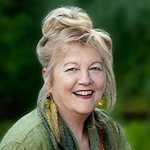The Day of the Dead event in San Rafael, Día de los Muertos, features a walking procession in the Canal neighborhood that is led by Aztec dancers and features floats. The police and fire departments escort the walkers, and the Boy Scouts help cordon off the streets. People carry candles. Last year, the event featured a big, paper-mâché mojiganga, Valentina, created by Barbara Clifton-Zarate and her family. This year, the organizers want to add more creative elements, like designing a new backdrop for their stage.
San Rafael’s 2022 Día de los Muertos celebration marks 34 years as a cultural community event at the Albert J. Boro Community Center & Pickleweed Park in the Canal neighborhood. Altars, art, and cultural activities will take place inside, and an evening community procession will move through the area. In 2020, with all the losses suffered because of COVID and the pandemic making the in-person tradition impossible, they added a car procession that traveled up to Fourth Street in San Rafael. The car procession was well received and is now part of the celebration. The same is true for the local downtown businesses and Art Works Downtown that displayed altars honoring lost loved ones in their storefront windows.
As the event for Día de Las Muertos in San Rafael grows, Multicultural Center of Marin’s organizing committee begins to meet each year in March. The event is possible thanks to the support of Marin Community Foundation along with local restaurants, local business sponsors, in-kind donation providers, and other nonprofits that join the efforts. During the summer, the committee is also focused on organizing all the different activities and getting the word out, as elements of the celebration are defined and confirmed.
“We line up performing artists and offer art workshops,” said Catherine John, last year’s Committee Chair and Arts & Culture Liaison, Multicultural Center of Marin. “We work with The Canal Arts. Some of the workshops over the years have been making paper flowers and decorating sugar skulls, always something having to do with the Day of the Dead theme. They are always a big hit with kids and families.”
The Multicultural Center of Marin’s Día de los Muertos website lists the Organizing Committee members and 15 partnering agencies. The committee works throughout the spring and summer, lining up artists and teachers. Some will work with people leading up to the event to create art for a display at the Boro Center. Others will provide free art activities on the Day of the event.
Ms. John noted that the materials are either provided by the artists or provided at no cost to the family. The entire event is gratis, which is why they work hard to find all the volunteers and in-kind contributions ahead of time. The event relies on local businesses that help with everything from donations and to those willing to place an event poster in their window.
Often, people think that Día de los Muertos is like Halloween because both traditions take place in the fall on almost the same date. In fact, Halloween takes place on October 31st and Día de los Muertos could begin at midnight on October 31 but is more often acknowledged on November 1st and 2nd, or another day, if the locality decides to pick another day. While the two events share skeletons’ images, their meaning and cultural aspects are quite different. Halloween, with its roots in Europe, originally honored the dead but became more about scary movies, dressing up in costume, and trick-or-treating. Día de los Muertos retains its Latin American, Indigenous cultural roots of celebrating the afterlife by welcoming the dead and honoring lost loved ones.
Ms. John explained, “We want to promote this event, especially to the rest of Marin who doesn’t know the Canal, never goes to the Canal, and maybe doesn’t have any contacts with the Latino immigrant population. We want them to know that it is open to all, and all are welcome to engage, especially now that we have these downtown elements in the form of the altars and the car procession, and of course, we’re looking for new sponsors.”

Kate Fitzsimmons is a freelance writer and fund development professional. Her writing skills were honed as a Contributing Editor to The San Francisco Review of Books where she interviewed John Updike, Joyce Carol Oates, Bobbie Ann Mason, Alice Walker and others. She works with businesses, nonprofits and entrepreneurs to assist them in raising their visibility through their stories. When she isn’t writing, she is cooking for friends, collecting art or engaged in a good novel.